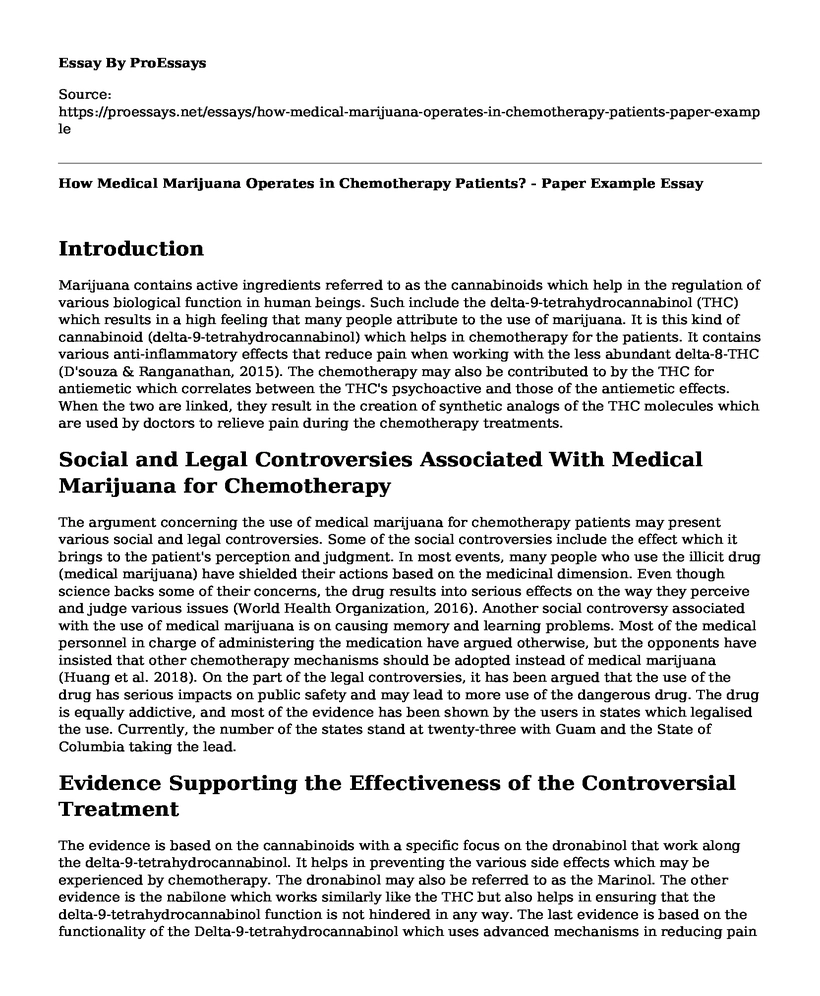Introduction
Marijuana contains active ingredients referred to as the cannabinoids which help in the regulation of various biological function in human beings. Such include the delta-9-tetrahydrocannabinol (THC) which results in a high feeling that many people attribute to the use of marijuana. It is this kind of cannabinoid (delta-9-tetrahydrocannabinol) which helps in chemotherapy for the patients. It contains various anti-inflammatory effects that reduce pain when working with the less abundant delta-8-THC (D'souza & Ranganathan, 2015). The chemotherapy may also be contributed to by the THC for antiemetic which correlates between the THC's psychoactive and those of the antiemetic effects. When the two are linked, they result in the creation of synthetic analogs of the THC molecules which are used by doctors to relieve pain during the chemotherapy treatments.
Social and Legal Controversies Associated With Medical Marijuana for Chemotherapy
The argument concerning the use of medical marijuana for chemotherapy patients may present various social and legal controversies. Some of the social controversies include the effect which it brings to the patient's perception and judgment. In most events, many people who use the illicit drug (medical marijuana) have shielded their actions based on the medicinal dimension. Even though science backs some of their concerns, the drug results into serious effects on the way they perceive and judge various issues (World Health Organization, 2016). Another social controversy associated with the use of medical marijuana is on causing memory and learning problems. Most of the medical personnel in charge of administering the medication have argued otherwise, but the opponents have insisted that other chemotherapy mechanisms should be adopted instead of medical marijuana (Huang et al. 2018). On the part of the legal controversies, it has been argued that the use of the drug has serious impacts on public safety and may lead to more use of the dangerous drug. The drug is equally addictive, and most of the evidence has been shown by the users in states which legalised the use. Currently, the number of the states stand at twenty-three with Guam and the State of Columbia taking the lead.
Evidence Supporting the Effectiveness of the Controversial Treatment
The evidence is based on the cannabinoids with a specific focus on the dronabinol that work along the delta-9-tetrahydrocannabinol. It helps in preventing the various side effects which may be experienced by chemotherapy. The dronabinol may also be referred to as the Marinol. The other evidence is the nabilone which works similarly like the THC but also helps in ensuring that the delta-9-tetrahydrocannabinol function is not hindered in any way. The last evidence is based on the functionality of the Delta-9-tetrahydrocannabinol which uses advanced mechanisms in reducing pain for most of the cancer patients (Volkow et al. 2014).
Evidence That Does Not Support the Effectiveness of the Controversial Treatment
Most of the patients who have undergone chemotherapy with the primary medicinal substance being the medical marijuana have always suffered some side effects in life. For example, experiencing a decline in cognitive function and having poor performance in either school work or other activities in the workplace. Their brain processes like decision making, conceptualisation, and the formation of ideas are also affected (Wilkie, Sakr & Rizack, 2016). Some of them also end up taking on the drugs later in life. Therefore, even as the drug is being argued by scientists to help in chemotherapy treatments, further results should be conducted with the aim of developing mechanisms which can help in mitigating the associated negative effects.
References
D'souza, D. C., & Ranganathan, M. (2015). Medical marijuana: is the cart before the horse? Jama, 313(24), 2431-2432.
Huang, I. C., Klosky, J. L., Bhakta, N., Hudson, M. M., & Robison, L. L. (2018). Marijuana/tobacco use and patient-reported outcomes (PROs) in adult survivors of childhood cancer.
Volkow, N. D., Baler, R. D., Compton, W. M., & Weiss, S. R. (2014). Adverse health effects of marijuana use. New England Journal of Medicine, 370(23), 2219-2227.
Wilkie, G., Sakr, B., & Rizack, T. (2016). Medical marijuana use in oncology: a review. JAMA oncology, 2(5), 670-675.
World Health Organization. (2016). The health and social effects of nonmedical cannabis use. World Health Organization.
Cite this page
How Medical Marijuana Operates in Chemotherapy Patients? - Paper Example. (2022, Jul 17). Retrieved from https://proessays.net/essays/how-medical-marijuana-operates-in-chemotherapy-patients-paper-example
If you are the original author of this essay and no longer wish to have it published on the ProEssays website, please click below to request its removal:







